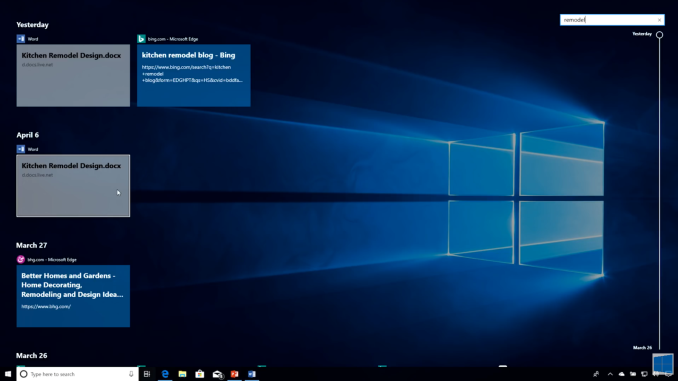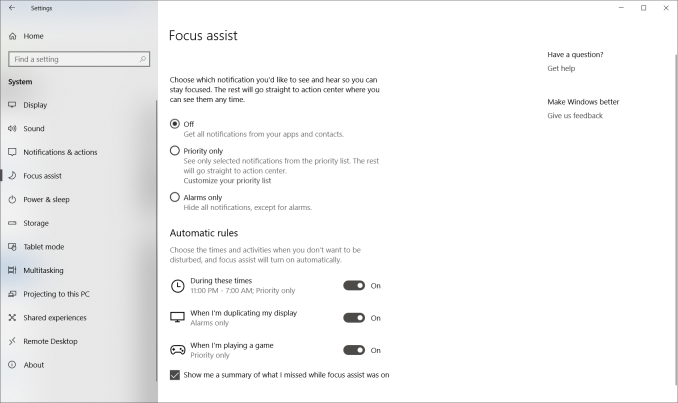The Windows 10 April Update (1803): The Littlest Big Update
by Brett Howse on May 25, 2018 8:00 AM EST- Posted in
- Software
- Operating Systems
- Windows
- Microsoft
- Windows 10
Timeline
Arguably the biggest feature new feature for Windows 10 is one aimed squarely at productivity. Timeline is part of the Task view feature that was previously in Windows 10, and accessed in the same way, either by clicking the icon on the task bar, or pressing Win + Tab. The idea of Timeline is to make it very easy to get back into a task you were doing previously or find some information you know you had open in a browser.
 Sorry for the poor screenshot but Timeline isn't working for me
Sorry for the poor screenshot but Timeline isn't working for me
By default, Timeline is only set to go back a single day, and apps will be sorted by hour. You can optionally enable it to go back 30 days as well, which seems like a more useful method to have as the default.
You can also adjust how Timeline works in the Privacy settings. When enabled, Timeline will sync activities from this PC, and also sync them to the cloud, so you can access documents and information across devices. But if you’d rather not have that data collected, you can disable the cloud sync, the local PC activity collection, or both.
Focus Assist
Another feature added with the April Update which focuses on keeping you focused is Focus Assist. After clamoring for notifications on the PC after seeing their benefit in mobile, it quickly became apparent that, while useful, notifications can also be a distraction.
In previous versions of Windows 10, Microsoft offers a Quiet Hours feature where you could set the PC to not provide notifications depending on the time, but with Focus Assist, that ability is expanded upon.
In addition to being able to schedule a time when notifications are muted, you can now change what level of notifications come through, with a custom priority list. You could in theory mute all notifications except those you want to see, which sounds fairly useful, or you could just set a time where you want to get some work done and only have alarms appear.
There’s also additional new automatic rules for notification action when duplicating a display, which will be very beneficial to avoid embarrassing notifications when using a projector, as well as when gaming.
Enabled by default is also a summary of notifications that were missed while focus assist was on, so if you were gaming, you’ll get a handy summary of everything that happened while you were having some fun, so you can get back to work.
This is of course still coupled with the notification settings where you can enable or disable notifications per-app.
Focus Assist is the kind of feature that Windows 10 needs. Notifications are great, but they can be distracting when you’re trying to get some work done. It would be great if Microsoft added some more settings here to allow you to create more automatic rules, such as when you have an app open, or additional time slots rather than just the single time you can enable it now.











161 Comments
View All Comments
Lolimaster - Wednesday, May 30, 2018 - link
Why have win10 installed in the 1st place, Win8.1 update 3 is rock solid with none of the bloatware and update when you want if you want to do it.SirPerro - Monday, May 28, 2018 - link
From a consumer standpoint, it's peanuts and an isolated case.But this is the kind of issues that make the enterprise admins say "fuck it, I'm not updating this shit"
kuttan - Sunday, May 27, 2018 - link
Not just him I am another casualty of April 2018 update and was forced to revert to v1709. Only gamers who don't face much issues with April 2018 update because they don't use or have any idea outside gaming application or usage.lmcd - Monday, May 28, 2018 - link
I mean the system he described there is pretty normal except for the RAID config. If that's hardware RAID the system shouldn't even know, right? I assume it's hybrid RAID which would explain the problems, but still: I wouldn't expect a system composed of standard parts released in the last 2-3 years to run into issues.jordanclock - Friday, May 25, 2018 - link
What kind of SSDs are you using?BurntMyBacon - Tuesday, May 29, 2018 - link
There are known issues with some Intel and Toshiba SSDs, but in this case, the RAID-0 may be the culprit. It is an extra driver that has to be accounted for and RAID-0 for boot drives have historically had weaker support (require extra steps and don't always work) than single drive setups across many versions of Windows. I also have an i7-6700K, 64GB RAM, and NVMe (Samsung 950PRO) boot drive setup. Update worked out fine for me, but I don't have RAID-0.Ophion - Friday, May 25, 2018 - link
Similar problems happened to two people I know, severe performance drops that made the system unresponsive. I personally had troubles even getting the update to install. Got stuck on a black screen with zero drive activity every time and had to roll back, until I unplugged every peripheral and it finally went through.And after doing so, the update apparently had reset all of my microphone settings and invalidated my display driver.
HStewart - Friday, May 25, 2018 - link
It is probably like my Xeon system, you have some drive - like my Realtek driver failing because it old.ಬುಲ್ವಿಂಕಲ್ ಜೆ ಮೂಸ್ - Sunday, May 27, 2018 - link
Cmon Stewie, your Realtek driver did not fail because it's oldIn fact, your driver still works fine
It failed because you installed Windows 10
bananaforscale - Sunday, May 27, 2018 - link
Drivers aren't hardware, they don't fail because they are "old". Your understanding of computers could use brushing up. If something that has worked previously on an OS fails after an update it's not an age issue, it's a bug (or as some might say "a regression").